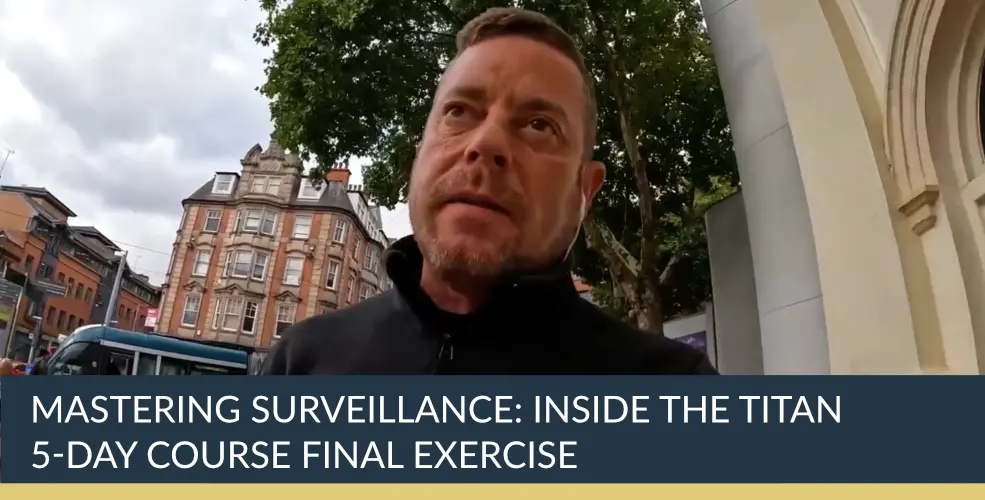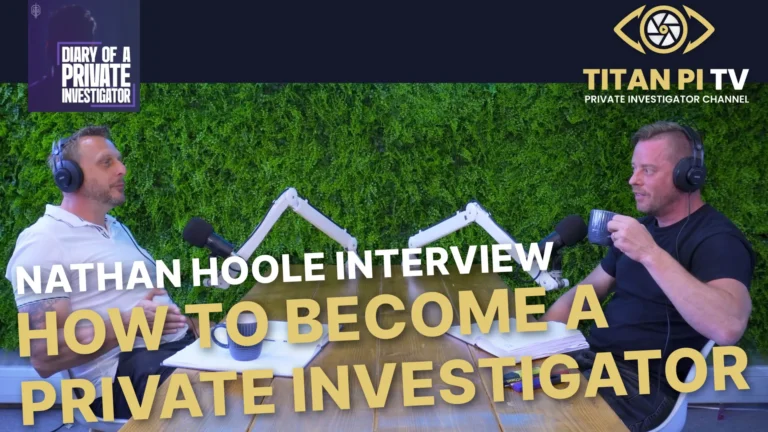Mastering Surveillance: Inside the Titan 5-Day Course Final Exercise
Imagine the tension in the air as a team of trainees faces their biggest test yet. One wrong move could mean losing track of the target forever. This is the final exercise in Titan Private Investigation’s five-day surveillance course, where skills get pushed to the limit in a setup that mirrors real-world ops.
Titan Private Investigation, based in Derby, UK, runs this intense training to build top‑notch surveillance professionals. The course covers everything from basic tailing to handling tricky urban chases. By the end, only the sharpest minds advance, ready for actual cases such as infidelity enquiries, insurance fraud probes, witness verification, employee misconduct investigations and asset tracing.
Setting the Stage: From Twelve to Ten
The course started with twelve eager participants drawn from varied backgrounds—ex‑military, close protection, uniformed services, and career‑changers with razor‑sharp observational skills. Now, just ten remain for the final push. Two withdrew after honest self‑assessment and instructor feedback determined they weren’t quite ready for the pace and mental load. Crucially, the training team sees promise in both and plans to bring them back once they have consolidated the fundamentals.
This cut underscores the high bar at Titan PI. Surveillance demands quick thinking, emotional control, and seamless teamwork. There’s no room for slip‑ups when livelihoods, legal outcomes, or personal safety may hang in the balance. Attrition is not failure; it’s a safeguard that protects clients and elevates standards.
Titan PI TV and the Operational Briefing
Simon Henson, Titan’s Managing Director and host of Titan PI TV, leads the charge. His series offers a rare, candid look into the life of a modern investigations agency, with training content designed to educate aspiring operatives and inform discerning clients about what “good” actually looks like. Episodes are available as podcasts as well—perfect for on‑the‑go learning, post‑op debriefs, or revisiting key tactics.
Before the action begins, the team huddles for a structured briefing using the II MARCH format—a professional framework that ensures nothing is left to chance:
- Intention: What success looks like and how it will be measured.
- Information: Subject details, vehicle descriptions, addresses, and behavioural patterns.
- Method: The surveillance plan—foot, mobile, static, technical—plus contingencies.
- Administration: Roles, comms protocols, call signs, fuel, welfare, and timings.
- Risk: Legal considerations, public safety, conflict avoidance, and escalation thresholds.
- Communications: Primary and secondary channels, brevity codes, and fallback signals.
- Handover/Headings: Task transitions, relief plans, and criteria for terminating the op.
Trainees plot positions around the target area. Vehicles park strategically; foot teams blend into the environment. The objective is a smooth, unremarkable start that avoids early chaos. Professional surveillance is invisible by design—success looks like nothing at all.
The Criticality of the Initial Extraction (The “Lift”)
A strong “lift” sets the tone for the entire day. In surveillance parlance, the “lift” is the moment the subject first moves and the team establishes control—quietly, efficiently, and without spooking the target. Get it right and the operation flows; get it wrong and you’ll play catch‑up for hours, burning people and fuel, and risking compromise.
At Titan, instructors hammer home the lift’s importance. Picture starting a race with a flat tyre. That’s a bad lift. It can unravel meticulous planning in seconds and can prompt subject “cleaning” behaviour—unexpected U‑turns, loop backs, or sharp deviations designed to flush a tail.
Subject Control and Pre‑Deployment Tactics
The scenario begins at a Derby hotel car park. Control starts before movement:
- One foot unit remains inside, maintaining low‑key visual on the subject.
- The subject’s vehicle is parked, unguarded, but observed from a discreet distance.
- The area is sanitised—no unusual clustering, no “team tells,” no repeated faces.
Vehicles are positioned near likely exit routes, engines cool, drivers calm. The target is to plant a tracker on the vehicle while the subject is distracted—perhaps during check‑out or coffee. Done properly, the subject remains oblivious. The clock matters here; timing is everything. Keep the subject occupied too long and it looks contrived; too little and the technical team risks exposure. It’s a choreographed dance performed in real time, among real people, who must never suspect a thing.
Fail‑Safe Measures: Deploying Technical Surveillance
Electronic tracking devices serve as the ultimate safety net. Once deployed (lawfully and ethically, under Titan’s strict protocols and client authorisations), they provide location pings in near real‑time. Even if visual contact breaks—because of heavy traffic, a missed light, or an unexpected lane change—the team retains situational awareness.
On this run, the lift was textbook. Visual contact remained unbroken, and the tracker was held in reserve. That redundancy is not waste; it’s risk management. Technical tools transform potential disaster into a recoverable moment. The gold standard is visual surveillance complemented by smart tech, giving the team multiple layers of control without relying solely on any single one.
Navigating Complex Environments: Car Parks and Shopping Centres
The subject departs and drives to a multi‑storey car park in Derby. These are notoriously tricky—narrow lanes, camera blind spots, mirrors, and sudden turns. Operatives switch modes smoothly:
- Mobile teams become foot teams within seconds.
- A cover vehicle maintains distance, ready to reengage when the subject exits.
- Foot operatives adjust to pedestrian pace and prevailing footfall patterns.
The subject then walks into the shopping centre—crowded, reflective, full of distractions. This is where inexperience shows; Titan’s trainees are taught to declare the move early, deploy methodically, and avoid “ratcheting”—that panicked pile‑in that screams “team”. Instead, coverage is assigned with purpose.
Foot Surveillance Protocol in Retail Spaces
The near‑side/off‑side model comes into its own:
- Near side: The operative closest to the subject, maintaining discreet, credible proximity.
- Off side: Operatives positioned to absorb angles, manage escalators and lifts, and watch exits.
In Derby, the subject pauses at The Bear for a coffee. Operatives spread naturally—one near, one off, one ahead, one in reserve—mirroring typical patron behaviour. One operative browses adjacent shops to vary sight lines and avoid repetition. The aim is to be everywhere and nowhere simultaneously, blending into the ambient choreography of everyday life.
This method shines in dense environments. It prevents duplication (“the same face again”) and reduces the risk of a “heat check” by the subject. Trainees learn posture, pace, and pattern—the soft skills that make the hard skills work.
Maintaining Control in Congested Indoor Areas
Next stop: Marks & Spencer, a three‑floor anchor store. The call goes out—“All units enter. Standard floor coverage.” One operative takes direct visual; others position across levels, resisting the urge to follow on the same escalator or queue behind the subject at tills. Surveilling too close creates a visible pattern; intelligent positioning creates control.
When the subject hops between lifts and stairs, the team anticipates arcs rather than shadowing steps. They position for intercepts, cover egress points, and maintain clean lines of sight from mezzanines and balcony rails. The outcome: control held, exits covered, no gaps.
Escalating Complexity: Tracking Cross‑City Transit
The chase migrates to the M1 northbound. The subject cruises lane two at 64 mph—close enough to hustle, slow enough to lull. One cover vehicle sits back, feeding disciplined, factual updates over comms: speed, lane, traffic density, signage, and upcoming junctions.
At Junction 25, the subject exits to a park‑and‑ride near Nottingham and boards a tram. Foot units transition to public transport while vehicles shadow from roads in parallel. This blend—car to foot to tram, then back again—mimics the messy reality of live operations. The team must pivot without pause, balancing proximity against profile.
The Art of Public Transport Cocooning
On the tram, the “cocoon” tactic is textbook:
- One operative with a clear view, mid‑carriage, acts as the primary eye.
- Others bookend across the front and rear carriages, maintaining visual corridors and exit control.
- Signals are subtle—phone gestures, bag shifts, and coded phrases—never obvious.
The bustle of commuters is a gift. In crowds, professionalism becomes invisibility. The inner watcher leads; outers control flanks. The subject disembarks in Nottingham city centre, none the wiser, and the cocoon dissolves back into the flow of pedestrians.
Readying for the Next Transition
Shadow vehicles follow the tram route at a respectful distance. The logic is simple: the subject could meet a third party, hail a taxi, or divert into a side street. Having four cars looped in, ready to peel off, gives the team options. In surveillance, options equal safety and success. The best teams remain poised without being twitchy, disciplined without being rigid.
Testing Commitment: Multi‑Floor Department Store Operations
Off the tram and into the Victoria Centre—then into John Lewis, a multi‑level maze of possibilities. This is where trainees either commit to the method or fall into the trap of “chase and hope.” Titan drills the method:
- Allocate floors.
- Cover escalators and lifts from opposing angles.
- Assign “floaters” to plug gaps and manage unexpected movements.
- Keep exits watched. Always.
There’s no drama, no heroics—just calm, professional coverage that respects the environment and the subject’s right to go about their day unimpeded.
Floor Management and Exit Strategy
The subject hits floor three. Eyes are already there. No one sprints; no one stares. When the subject drops to floor two, watchers shift laterally, not vertically in parade. The key rule holds: don’t mirror every step. Position ahead. Anticipate. Think in “arcs” and “zones,” not footsteps.
Every exit has eyes—not a cluster, not a cordon, but credible, everyday people moving with purpose. The result is a soft “box” that never feels like a box.
Close Control Under Duress: The Café Scenario
The subject settles into a café. One operative takes a seat with a natural vantage. Others manage near side, off side, and the window line. When the subject visits the toilet, the team quietly re‑weights coverage to ensure there’s no blind moment on exit. The four‑person model flexes elegantly to absorb the pause without creating a presence spike.
Instructors later praise the team’s calm. Cafés are deceptively difficult—close quarters, reflective glass, and the temptation to over‑observe. Here, restraint won.
Ethics, Legality, and Professional Standards
Beyond tactics and timing, Titan stresses the legal and ethical framework that governs professional surveillance in the UK:
- Necessity and proportionality underpin every instruction and action.
- GDPR and data protection duties shape the handling of images, notes, and reports.
- Privacy is respected; the objective is to observe, record, and report—never to provoke or interfere.
Trainees are taught that integrity is a non‑negotiable. The cleanest evidence is gathered unobtrusively, corroborated across multiple observations, and documented with precision. Courts respect professionalism—and spot theatrics a mile away.
Comms Discipline: The Invisible Glue
The day’s success rests on tidy comms:
- Brevity: short, factual, relevant updates.
- Consistency: standard call signs, unambiguous locations, and agreed terminology.
- Contingency: immediate switches to alternate channels if needed, backed by simple fallbacks like time stamps or cardinal directions.
Good comms are quiet confidence—no over‑talking, no panic, no jargon spaghetti. The best comms leave a clear audit trail and reduce cognitive load across the team.
Debrief Culture: Turning Reps Into Mastery
At Titan, the operation doesn’t end when the subject steps off. It ends after the debrief—honest, structured, and constructive:
- What worked? Lift timing, coverage discipline, and transitions.
- What faltered? Moments of bunching in retail flows, one late call on a lift transition.
- What changes next time? Earlier declaration of store entry, sharper zoning on floor coverage, and tighter welfare rotation.
Debriefs are where trainees become professionals. Ego is checked at the door. Everyone learns; everyone improves.
Equipment and Readiness: The Professional Edge
While skill trumps kit, equipment matters:
- Comms: encrypted, tested, with spare batteries and car chargers.
- Optics: discreet; binoculars when appropriate, but often eyes and angles suffice.
- Clothing: credible for the environment—no uniformity, no tactical “tells,” and always weather‑appropriate.
- Vehicles: clean, unremarkable, and mechanically sound, with sat‑navs muted and screen brightness managed at night.
Readiness is respect—respect for the craft, the client, and the public.
Defining a Successful Surveillance Operation
The final exercise wrapped with ten trainees shining. They nailed the lift, handled urban twists, and executed complex transit transitions without losing their cool. Adaptability and team synchronisation defined their win. They looked like Titan material because they operated to Titan’s standard: quiet, disciplined, ethical, and effective.
From Derby hotels to Nottingham shops, every step mirrored real‑world operations. The two who paused their journey will return stronger—because growth is part of the game, and standards at Titan are never compromised.
Key Takeaways for Aspiring Surveillance Operatives
- Nail the initial lift. A smooth start compounds success; a shaky one compounds risk.
- Use tech as a safety net, not a crutch. Visual control plus tracking redundancy equals resilience.
- Master foot placements. Near/off‑side beats blind following every time, especially in retail environments.
- Cocoon on public transport. Position smartly, use crowds, and control egress points without being seen.
- Think in arcs and zones, not footsteps. Cover levels and exits in large stores; resist mirroring the subject.
- Keep comms tight. Short, factual, timely—no drama, no clutter.
- Respect the law and ethics. Professionalism is your licence to operate and your credibility in court.
- Debrief like a pro. Honest feedback turns reps into mastery.
These lessons are straight from the field and reinforced in Titan’s training room. Apply them, and your work will speak for itself.
Are You Ready for the Titan Standard?
Surveillance isn’t for the faint‑hearted. It demands nerve, intelligence, and patient repetition—hours of quiet for moments that matter. If this excites you, explore Titan PI’s five‑day surveillance course. Step into the shadows under expert guidance and discover whether you’ve got the mettle to operate at a professional level. The next intake awaits those ready to learn, ready to adapt, and ready to uphold a standard that clients trust and courts respect.
To learn more about Titan Private Investigation’s services and training, or to follow the latest episodes of Titan PI TV, visit Titan’s channels and see the craft up close—from the discreet calm of a perfect lift to the disciplined choreography of a city‑wide follow. Your professional journey could start with a briefing—and end with a standard you’ll be proud to uphold.
About Titan Private Investigation Ltd
Titan Private Investigation Ltd is a leading provider of corporate and private investigation services in the UK. Based in Derby, the company serves clients nationwide, offering a full range of investigative solutions including surveillance, fraud investigation, digital forensics, and more. We are a private investigation agency with a reputation for professionalism, discretion, and delivering results. Titan is the trusted partner of choice for businesses seeking to protect their interests and ensure compliance.
London Surveillance Training Course – Call the Titan Investigations London Office 020 39046622
Birmingham Surveillance Training Course – Call the Titan Investigations Birmingham Office 0121 7162442
Cambridge Surveillance Training Course – Call the Titan Investigations Cambridge Office 01223 662022
Derby Surveillance Training Course – Call the Titan Investigations Derby (Head Office) 01332 504256
Leeds Surveillance Training Course – Call the Titan Investigations Leeds Office 0113 4574066
Leicester Surveillance Training Course – Call the Titan Investigations Leicester Office 0116 2436520
Nottingham Surveillance Training Course – Call the Titan Investigations Nottingham Office 0115 9646950
Manchester Surveillance Training Course – Call the Titan Investigations Manchester Office 0161 3023008
Sheffield Surveillance Training Course – Call the Titan Investigations Sheffield Office 0114 3499400
Truro Surveillance Training Course – Call the Titan Investigations Truro Office 01872 888706
Alternatively, you can contact us directly using our fully confidential contact form at enquiries@titaninvestigations.co.uk or chat directly using our Live Chat facility, and one of our UK Private Investigators will get right back to you.





















